Analysis of the performance of a new type of rotorcraft
DOI:
https://doi.org/10.24136/atest.2019.152Keywords:
rotorcraft, gyroplane, aircraft equipment, aerodynamic propertiesAbstract
The article analyses the performance of the newly designed rotorcraft. A new concept for the equipment and use of rotorcraft for transport purposes was also presented. The work focuses on the use of gyroplanes for these purposes as a special type of rotorcraft with specific properties. The initial aircraft design developed and described includes structural assumptions, technological solutions, cabin / cargo ergonomics, economy and operational safety. Particular attention has been paid to rotorcraft equipment depending on which version it is to be configured to. The work also includes the design of the initial geometry of the rotorcraft. A solid showing the formulated assumptions that will be used for numerical analysis is presented. On its basis, an approximate analysis was made of the determination of basic performance and mass distribution depending on the equipment version. In addition, the method of numerical analysis of rotorcraft body and its results together with their development is presented. The results of numerical simulation were analyzed and conclusions regarding the correctness of gyroplanes for transport purposes were formulated.
Downloads
References
Bzowska-Bakalarza M., Trendak A., Marszałek D.: Aerial method of plant protection with the use of an autogyro for sustainable agriculture, Agriculture and Agricultural Science Procedia 7 (2015), s. 54 – 58
Cieślak S.: Analiza możliwości zwiększenia prędkości przelotowej i zmniejszenia poziomu hałasu wiatrakowca, Prace Instytutu Lotnictwa (219) 2011, s. 31-38,
Czyż, Z. Ilhan, I. Akcay, M. Czarnigowski, J.: Air flow analysis around the autogyro fuselage, Journal of Technology and Exploitation in Mechanical Engineering, Vol. 3, nr 1 2017, s. 13-20
Czyż, Z. Łusiak, T. Magryta, P.: Badania numeryczne CFD wpływu usterzenia na charakterystyki aerodynamiczne wiatrakowca, Prace Instytutu Lotnictwa, Nr 5-6 (232-233) 2013, s. 5-16
Czyż, Z. Magryta, P. Szlachetka, M.: Experimental investigation of the impact of flight speed on drag force in the autogyro model, Advances in Science and Technology Research Journal, Vol. 9, nr 26 2015, s. 89-95
Czyż, Z. Łusiak, T. Czyz, D. Kasperek, D.: Analysis of the pre-rotation engine loads in the autogyro, Advances in Science and Technology Research Journal, Vol. 10, nr 31 2016, s. 169-176
Dąbrowski, W. Popowski, S. Rybaniec, R.: System do pomiaru i rejestracji wybranych parametrów pilotażowo nawigacyjnych wiatrakowca, Prace Instytutu Lotnictwa, Nr 10 (219) 2011, s. 47-58
Delega, M. Krzymień, W.: Weryfikacja rozwiązań prerotacji wirnika wiatrakowca, Prace Instytutu Lotnictwa, Nr 3 (236) September 2014, s. 35-40
Delega, M.: Głowica wiatrakowca IL-28 umożliwiająca pionowy start, Prace Instytutu Lotnictwa, Nr 7 (202) 2009, s. 18-23
Department of Transportation, Federal Aviation Administration: Rotorcraft Flying Handbook, 2000.
Głowacki B.: Modułowe uzbrojenie dla śmigłowców, Skrzydlata Polska Nr 9 (2443)/2016, s. 30-34.
Grzesik N., Picher S.: Wyposażenie specjalne wybranych statków powietrznych, WSOSP, Dęblin 2013.
Gunston B., Spick M.: Ilustrowana encyklopedia, Współczesne śmigłowce bojowe, Espadon, 1993.
Houston S., Thomson D.: On the modelling of gyroplane flight dynamics, Progress in Aerospace Sciences, Volume 88, January 2017, Pages 43-58
Instrukcja użytkowania w locie śmigłowca SW-4, Wytwórnia Sprzętu Komunikacyjnego „PZL Świdnik”, Świdnik 2005.
Krzymień, W.: Zagadnienia bezrozbiegowego startu wiatrakowca, Prace Instytutu Lotnictwa, Nr 4 (241) 2015, s. 54-61
Pietrosiński, M.: Wpływ geometrii profilu lotniczego łopaty wirnika głównego na osiągi wiatrakowca, Prace Instytutu Lotnictwa, Nr 4 (241) 2015, s. 62-72
Pietrzak W. B.: Śmigłowce szturmowe, Przegląd techniki wojskowej XXI cz. 4, E-bookowo, 2016.
Ruchała P., Stryczniewicz W., Czyż Z., Łusiak T.: Charakterystyki aerodynamiczne kadłuba wiatrakowca, dla różnych kątów zaklinowania usterzenia poziomego, Prace Instytutu Lotnictwa, Nr 4(241), s. 96-107
Skorupka Z., Tywoniuk A.: Wybrane zagadnienia konstrukcji podwozia do wiatrakowca I28, Prace Instytutu Lotnictwa (232) 2013, s. 32-38,
Stalewski, W.: Aerodynamic design of modern gyroplane main rotors, Prace Instytutu Lotnictwa, Nr 1 (242) 2016, s. 80-93
Stalewski, W.: Improvement and optimisation of gyroplane performance, Prace Instytutu Lotnictwa, Nr 4 (249) 2017, s. 103-122
Stalewski, W.: Symulacja startu wiatrakowca w oparciu o program fluent z modułem VBM, Prace Instytutu Lotnictwa, Nr 2 (211) 2011, s. 155-170
van Veenendaal J.: Amerykańskie śmigłowce Apache w Europie, Lotnictwo 6/2016, s. 64-67.
https://defence-blog.com/news/photos-of-chinese-military-gyrocopter.html (dostępne w dniu 17.09.2018)
https://www.helis.com/50s/rotodyne.php (dostępne w dniu 17.09.2018)
http://trixyaviation.com/trixy-eye.html (dostępne w dniu 17.09.2018)
https://innpoland.pl/133467,polacy-wymyslili-statek-powietrzny-w-cenie-dobrego-samochodu-nad-morze-doleci-w-dwie-godziny (dostępne w dniu 17.09.2018)
http://celieraviation.com.pl/c-44.html (dostępne w dniu 17.09.2018)



